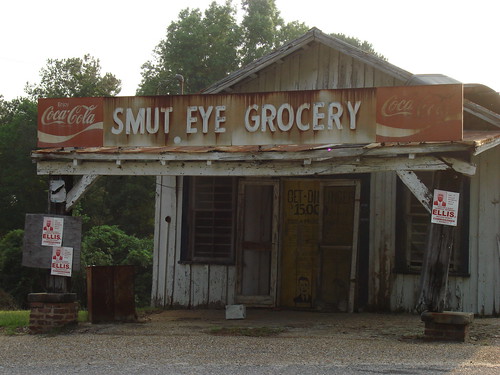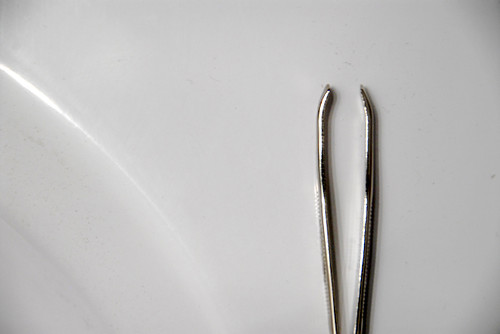Well I can only imagine the folks at Threadless must be pretty darn happy with their recent Inc. cover story. I mean, “Most Innovative Small Company In America,” it doesn’t get much better than that! If you somehow still are not familiar with Threadless, and why it’s so popular among democratization-of-everything biz theorists, the piece offers a comprehensive and extremely positive overview. (I attempted to make some different points about the Threadless model in this 7/8/07 Consumed.)
A few minor things interested me the most, though they were not the focus of the piece:
1. There’s passing mention of the break between co-founders Jake Nickell and Jacob DeHart; the latter is still on the board but “no longer works at the company,” and declined to be interviewed. I wonder what the story is there? Has someone else written about that and I missed it? The article says DeHart “had lost interest in expanding Threadless.” Why? This made me curious about what he’s up to, and I sort of wished for a sidebar about him.
2. The company’s Naked & Angry sub-brand or spinoff or whatever it is, is described as coming “later this year.” This idea has sort of been in a beta mode for an awfully long time. I’m sure curious to see what it develops into.
3. On a related note, I either didn’t know or had forgotten that Insight Venture Partners has a stake in Threadless. I wonder what this implies about the brand’s future? It doesn’t sound like they would have needed venture money, since the story says they’re making 30% margins. And by and large, venture capitalists are looking for blow-out growth, or rather blow-out valuation increases (and “liquidity event”). Threadless has started opening stores, and according to the story is open to other retail arrangements (including Urban Outfitters under the right circumstances). No doubt Threadless is a good business, but I don’t see it being an IPO candidate unless they make some pretty radical steps.
None of this is meant to suggest I see any particular trouble on the horizon for Threadless. I don’t. But they do seem to be reaching a crossroads of some kind. It’ll be interesting to see which way they go.
(Related: In addition to the aforementioned Consumed column, I did a Q&A here on Murketing with Threadless star Glenn Jones about his own brand.)
You can make one out of a map (via Craftzine):

Or, if you prefer, out of a book (via Coudal):

Or if you’re extra ambitious: Make a messenger bag — out of bags! (Trash bags, no less.)

Leif Parsons, who had a wonderful run as the illustrator of Consumed, has a show coming up (with his friend Duane Burton) — in fact the opening is Thursday night. Details:
Invisible NYC
148 Orchard Street NYC
May 29th through June 28th
[Tuesday through Saturday from 12-8)
Opening Thursday May 29th 7-10
Check it out!
Save
 Here’s an odd rabbit hole I just fell into and climbed out of: Zune fandom.
Here’s an odd rabbit hole I just fell into and climbed out of: Zune fandom.
An item on Listening Post about Gamestop deciding not to sell Zunes anymore jokily noted that this “could lead to a bunch of the Zune-logo-shaped neon signs that have shown up there becoming available on eBay, much to the delight of Zune freaks everywhere.”
Zune freaks? Are there Zune freaks? The post offered this link, showing a guy with a Zune logo tattoo (I wouldn’t have recognized the Zune logo on a bet prior to this), but the link underneath it went to a site called Zunescene that wouldn’t load.
Still, I Googled a bit and found ZuneLuv.com and ZuneMax.com and ZuneWorld.com and Zunely.com and I stopped.
I didn’t spend enough time at any particular site to gauge the fandom (or suss out to what extent the point seemed to be to aggregate ads). But I guess a million Zunes have been sold, so obviously there is such a thing as Zune fandom, but it suddenly made me curious about the nature of it. Is there a kind of contrarian cachet to Zune ownership? Is there a kind of anti-snob appeal in rejecting Apple, which I guess is basically the conformist choice of portable music devices, given its market share? Do Zune fans get excited when they spot each other on the subway or in a cafe?
Is there … a cult of Zune?
The Wall Street Journal today has a review of a novel called Dear American Airlines, written by Jonathan Miles. The novel takes the form of an “angry” 180-page letter, composed by “a 53-year-old failed poet and former alcoholic,” stranded at O’Hare because of a flight cancellation that could make him miss his daughter’s wedding.
While anger at the carrier isn’t the book’s plot, but rather (from the sound of it) a narrative device used to draw a portrait of the letter-writer, the timing is pretty amusing, given mounting consumer hostility to airlines in general, and possibly to American in particular since it made news by announcing a fee on checked luggage. (Update: Ad Age on American Airlines backlashing.)
So I’m sure American can’t be too excited about this, and I wonder: Do you have to get permission to use a real company’s name in the title of a novel?

Or at least that’s what I assume is going on here. From an NYT story over the weekend about Ron Paul fans.
 FLIPPED OUT
FLIPPED OUT
Convenience makes a good-enough camcorder a hit
In Consumed this week, an object lesson in the awesome power of convenience — and when it trumps quality itself.
In the consumer-products world, progress can be gauged in measurable increments of improved quality. Contemporary consumers demand such improvements all the time and refuse to compromise on the good-enough when the better is available. So marketplace success depends on quality breakthroughs: tastier coffee, faster computers, smoother-riding cars. This is always true — except when it isn’t….
 A high-enough degree of convenience is exactly what makes a “good enough” product consumable. Digital-compression formats like the MP3 and most of its successors have entailed a step down in audio quality — but for most listeners, they’re “good enough” when you consider that they’re obtainable instantly (and, often, free). As Fleming-Wood points out, the camera business went through its own version of this epiphany decades ago, with the rise of one-button devices that couldn’t possibly match the quality of single-lens-reflex cameras but were far more accessible….
A high-enough degree of convenience is exactly what makes a “good enough” product consumable. Digital-compression formats like the MP3 and most of its successors have entailed a step down in audio quality — but for most listeners, they’re “good enough” when you consider that they’re obtainable instantly (and, often, free). As Fleming-Wood points out, the camera business went through its own version of this epiphany decades ago, with the rise of one-button devices that couldn’t possibly match the quality of single-lens-reflex cameras but were far more accessible….
Read the column in the May 25, 2008 issue of The New York Times Magazine, or here.
Consumed archive is here, and FAQ is here. Consumed Facebook page is here.
Missed this earlier, but Brandweek had an interesting quick overview of how e-waste “has gone from being a headache to a marketing tool.” Example:
Sony, which [recently] announced the availability of its lower cost Bravia M line of LCD TVs, has paired with Waste Management, Houston, for a series of events around the country. The “Take Back Recycling Program” invites consumers to leave behind their unwanted devices for no charge.
The mention of the new LCD TVs is relevant, because it sounds like most of these efforts are being positioned as add-ons to campaigns that are, inevitably, focused on getting you to trade up to something new (which is of course a big part of the e-waste problem to begin with). As Brandweek notes, there’s a good chance that concern about e-waste is only going to get more intense in the near future, as the switch to digital broadcasting consigns a huge number of cathode-ray TV sets to the dump.
So in a way this trend, if it’s real, seems more defensive than enlightened. And it all falls far short of manufacturers flat-out taking responsibility for their products in an end-to-end way that, say, Greenpeace encourages. But whatever. Maybe it’s a good start, maybe it gets the issue into more consumer minds, and it’s certainly better than nothing.
 It doesn’t take much to make me happy.
It doesn’t take much to make me happy.
<– This is an example. Via Book of Joe.
Murketing’s weekly roundup of backlashes, dissent, and critiques:
1. Noah Brier‘s Brand Tags project doesn’t really have anti or backlashy intentions, I don’t think, but it’s really made the rounds and is worth noting as a kind of critique-enabler. If you haven’t seen it, basically the idea is you pick a brand from a list and enter the first word that you associate with the brand, then you click for the results: A tag cloud where the size of the words shown indicates how often people have typed them in as their gut reaction to a brand.
Needless to say, those gut reactions can result in some pointedly anti sentiments.
The most interesting one to me is the cloud for Twitter, which rather prominently features reactions such as “annoying,” “pointless,” “stupid” and “useless.” Meanwhile, lots of people also seem to love Twitter, and see it as wildly important. (I’ll never forget this Johnnie Moore post in which he suggested that asking “what’s the point of Twitter?” is like asking “What’s the point of life?” So if you don’t like Twitter, kill yourself?)
I just can’t get worked up about Twitter either way. Why do people have such extreme reactions to it?
 2. AdPulp points the way to Debranded Home, a site “committed to helping you reduce visual pollution by lessening brand presence in your home.” The idea is that once you’ve bought something and taken it home, “its label has served its purpose.” Debranded Home offers no-brand labels instead. (The set at right costs $9 plus shipping.) I assume the idea is you put the cleaning product or shampoo or whatever into another container of your choice, then put the new label on it. There are also how-to guides for making your own cleaners.
2. AdPulp points the way to Debranded Home, a site “committed to helping you reduce visual pollution by lessening brand presence in your home.” The idea is that once you’ve bought something and taken it home, “its label has served its purpose.” Debranded Home offers no-brand labels instead. (The set at right costs $9 plus shipping.) I assume the idea is you put the cleaning product or shampoo or whatever into another container of your choice, then put the new label on it. There are also how-to guides for making your own cleaners.
I suppose the noteworthy thing about this is that traditionally the argument over too-much-branding-and-advertising has been about public space. I suspect more people are bothered by branding that interrupts a walk in the park or whatever. But maybe this is the last resort, at least in your own home you can escape branding, even though it’s on stuff you actually bought?
Anyway … your thoughts?
List continues after the jump. Please continue…

As I assume most of you know, since I can’t shut up about it, Buying In comes out June 3. On Friday the 13th of June, I’ll be in New York doing an event to promote that book.
It’s at the Art Directors Club, 106 W 29th St. I will speak and read briefly, be interviewed by Fast Company‘s Danielle Sacks, take questions, then mingle and sign books or whatever.
Barking Irons, who are in the book, will be on hand doing a live screen printing session and will sell you a T-shirt made on the spot. I’ll also be giving away some letterpress posters featuring the above design, created by F-2 Design. Also we’re working a special guest DJ set. Not only that: “Drinks and canapes will be served.” Everyone will have a wonderful time.
I hope you’ll come. Additional details (and RSVP) is here
This event would not be possible without PSFK, to who whom I say: Thank you.
Also thank you to sponsor Fast Company. That’s another thing: You can pick up the June issue of Fast Company — which just so happens to include an excerpt from Buying In — while you’re there .
 Other news: Q&A with Eyecube here. Thoughtful writeups in Weatherpattern and Core77 and Lifefilter. Kind mention in Slate. Many pictures of people at Likemind events pretending to enjoy the book here. Other recent Buying In stuff here.
Other news: Q&A with Eyecube here. Thoughtful writeups in Weatherpattern and Core77 and Lifefilter. Kind mention in Slate. Many pictures of people at Likemind events pretending to enjoy the book here. Other recent Buying In stuff here.
Posted Under:
Flickr Artifacts by Rob Walker on May 22, 2008
Comments Off on Flickr Interlude
[Today Murketing.com brings you the latest guest Q&A, conducted by Ada Puiu, a senior at (or actually, I believe, a recent graduate of) the Schulich School of Business at York University in Toronto. Her earlier Q&As are here and here. More about Murketing.com guest Q&As here.]
Imagine going to bed one night, waking up, and discovering everything you owned (from the sentimental to the practical to the luxury) is gone. This is exactly what happened to designer Brian Jones. After waking up on the day of his big life move from San Francisco to Chicago, Brian faced the harsh reality that the van sitting outside his home, filled with all all of his possessions, had been stolen while he slept. After trying in vain to recover some of his life, he decided to look at this tragedy as an opportunity — a way to reach a better understanding of what it means to be a consumer.
Since late-August 2007, the Buy-By Brian Blog (buybybrianblog.com) has been a virtual diary of every item Brian has had to purchase (and repurchase) in order to rebuild the material part of his life. Some things (like pictures or his work) cannot be bought back. But in the more than 100 entries he has written over the past 9 months, he has chronicled every non-disposable item he has bought, and has given his readers an insight into what factors influence his buying decisions (need/want, price, sentimentality, etc). In reading his entries, I’ve actually found myself becoming more aware of how much we consume as a culture, and how easy it is to fill our lives with “wants” rather than ‘needs’ – something I was always aware of as a business student, but rarely got the chance to see illustrated in a real-life way.
Brian was kind enough to answer some questions for this Q&A, giving a little more insight into what this project means to him.
– Ada Puiu
Q: If it’s true that “you are what you buy,” you’ve pretty much opened up your entire life to your readers. You even make a point of recounting things you’ve bought that may be out of the norm, or even embarrassing (the tweezers, for example). Have you noticed your buying habits change at all with everything being so out in the open?
A: Ha, yes. I debated with myself about the tweezers for a while. Surprisingly that’s probably the most personal thing I’ve purchased. That and all my readers know that I prefer briefs to boxers. A lot of the personal items people buy usually fall under the “disposables” category, which I decided in the beginning not to include in this project.
As terrible as it was to lose all that I did, it was extremely liberating. I actually don’t like buying things now. After seeing how simple and clutter-free my life can be, every purchase makes me feel that much more weighed down. However, this conflicts quite a bit with me writing a blog about the things I buy. Sometimes I actually feel like I should go shopping just because it’s been two weeks since I posted something.
How much of what you’ve bought has actually replaced what you used to have, and how much has been things you’ve always wanted but never got around to purchasing? Please continue…




 "
"



 Here’s an odd rabbit hole I just fell into and climbed out of: Zune fandom.
Here’s an odd rabbit hole I just fell into and climbed out of: Zune fandom.

 FLIPPED OUT
FLIPPED OUT



















 Kim Fellner's book
Kim Fellner's book  A
A